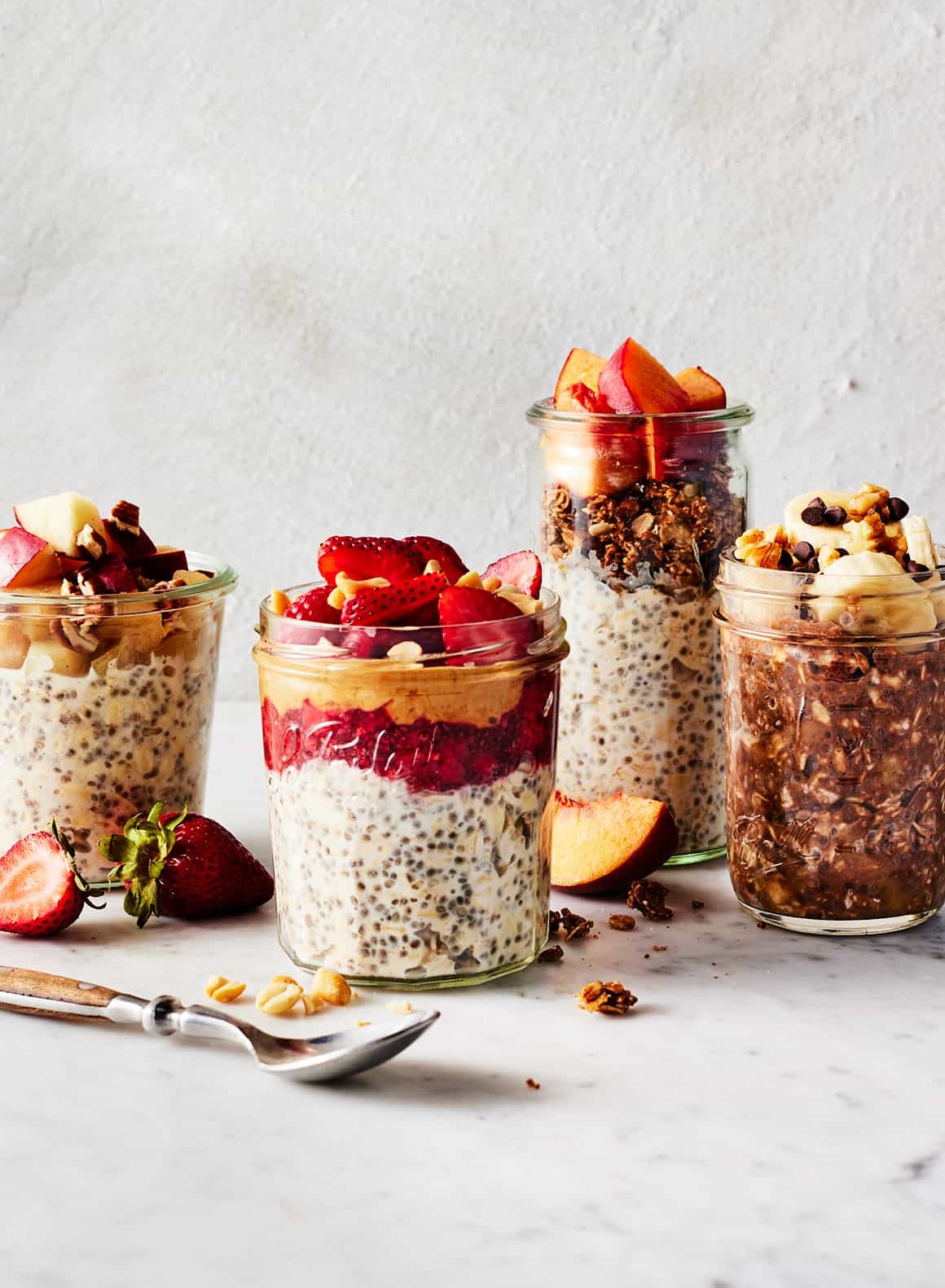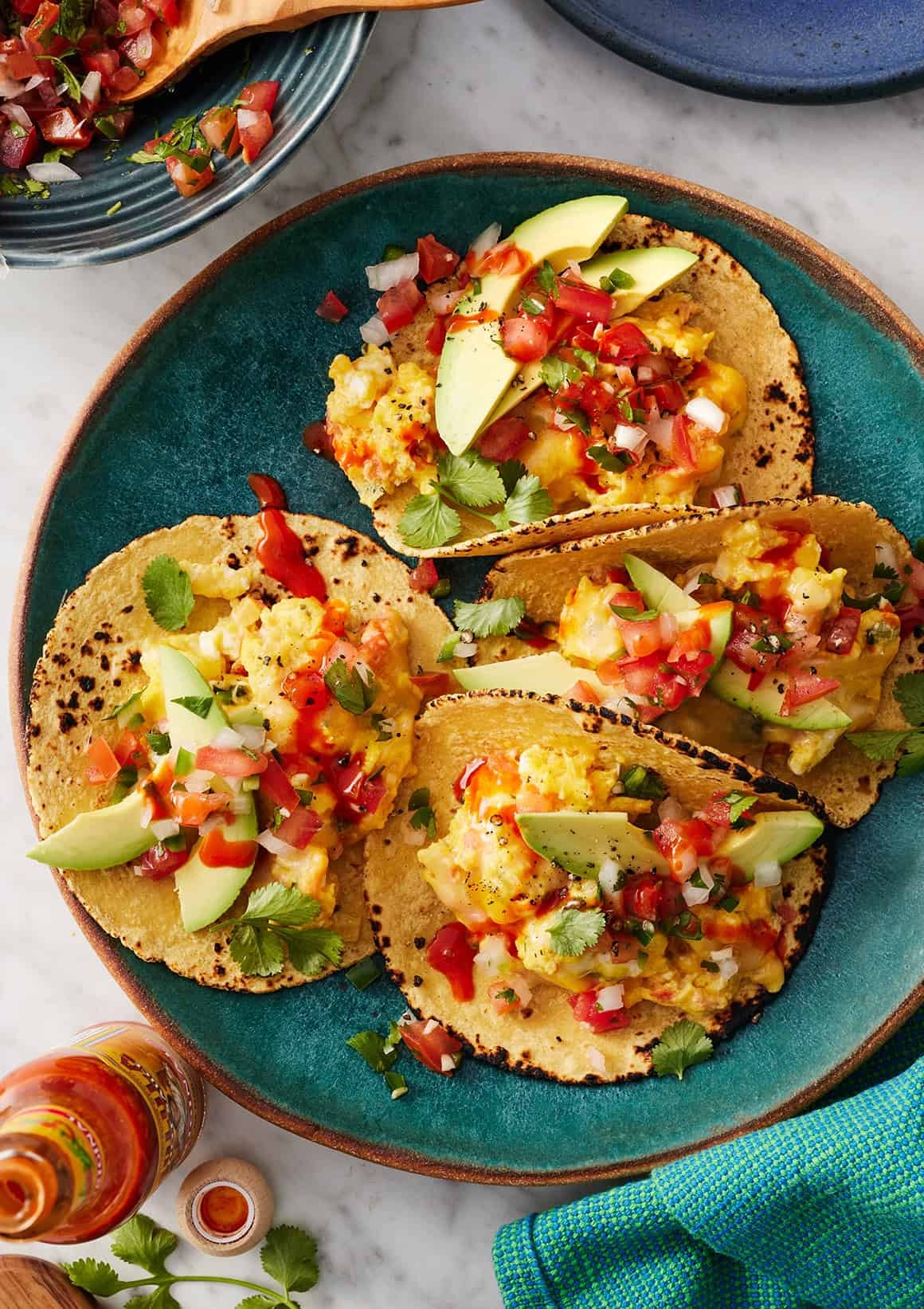Breakfast Foods are the cornerstone of a productive day, offering essential energy and nutrients. FOODS.EDU.VN brings you a treasure trove of delicious and healthy breakfast recipes to kickstart your mornings. Discover innovative breakfast ideas and nutritional tips, enriching your culinary experience.
1. The Importance of Breakfast Foods
Breakfast is often called the most important meal of the day, and for good reason. It provides the body and brain with the fuel needed to function effectively after an overnight fast. Skipping breakfast can lead to a range of negative effects, including decreased energy levels, poor concentration, and increased cravings for unhealthy foods later in the day. Let’s explore why breakfast foods are so vital and how they can contribute to overall health and well-being.
1.1. Energy Boost
After several hours without food, your body’s energy reserves are depleted. Breakfast replenishes these reserves, providing a much-needed energy boost to start your day. This energy is crucial for physical activities, mental focus, and overall productivity.
According to a study published in the Journal of the American Dietetic Association, individuals who eat breakfast regularly tend to have higher energy levels throughout the day compared to those who skip it.
1.2. Improved Cognitive Function
Breakfast has a significant impact on cognitive function, including memory, attention, and problem-solving skills. The brain requires a steady supply of glucose, which is obtained from the carbohydrates in breakfast foods.
A study in the American Journal of Clinical Nutrition found that children who ate breakfast performed better on cognitive tests than those who did not. This benefit extends to adults as well, with breakfast consumption linked to improved work performance and mental clarity.
1.3. Weight Management
Eating breakfast can help regulate appetite and prevent overeating later in the day. By starting with a nutritious meal, you’re less likely to experience intense hunger pangs that can lead to unhealthy snacking or consuming large portions at lunch and dinner.
Research published in the journal Obesity indicates that people who eat breakfast are more likely to maintain a healthy weight and have a lower risk of obesity.
1.4. Essential Nutrients
Breakfast provides an opportunity to consume essential nutrients that may be lacking in other meals. Fortified breakfast cereals, for example, are often rich in vitamins and minerals like iron, calcium, and B vitamins.
A balanced breakfast can also include fruits, vegetables, whole grains, and protein sources, contributing to a well-rounded and nutritious diet.
1.5. Better Mood
Starting your day with a satisfying meal can improve your mood and overall sense of well-being. Breakfast foods that are rich in complex carbohydrates and protein can help stabilize blood sugar levels, preventing mood swings and irritability.
A study in the International Journal of Food Sciences and Nutrition found that breakfast consumption was associated with improved mood and reduced symptoms of depression.
2. Diverse Breakfast Food Options
The world of breakfast foods is incredibly diverse, offering something for every taste and dietary preference. From quick and easy options to more elaborate dishes, there’s no shortage of ways to enjoy a healthy and delicious morning meal. Let’s explore some popular categories of breakfast foods and their nutritional benefits.
2.1. Oatmeal and Other Hot Cereals
Oatmeal is a classic breakfast choice, known for its heart-healthy benefits and versatility. It’s a good source of soluble fiber, which can help lower cholesterol levels and promote feelings of fullness. Other hot cereals like cream of wheat, farina, and quinoa porridge offer similar nutritional advantages.
Recipe Idea: Overnight Oats
- Combine 1/2 cup rolled oats, 1 cup milk (dairy or non-dairy), 1 tablespoon chia seeds, and your favorite toppings (fruit, nuts, seeds, honey) in a jar.
- Refrigerate overnight and enjoy cold in the morning.
2.2. Eggs
Eggs are a nutritional powerhouse, packed with protein, vitamins, and minerals. They’re a versatile ingredient that can be prepared in countless ways, from scrambled to fried to poached. Eggs are also a good source of choline, an essential nutrient for brain health.
Recipe Idea: Scrambled Eggs with Vegetables
- Whisk 2 eggs with a splash of milk and salt and pepper to taste.
- Sauté your favorite vegetables (such as spinach, bell peppers, and onions) in a pan with a little olive oil.
- Pour the egg mixture over the vegetables and cook, stirring occasionally, until the eggs are set.
2.3. Yogurt
Yogurt is a creamy and delicious breakfast option that’s rich in protein, calcium, and probiotics. Probiotics are beneficial bacteria that support gut health and boost the immune system. Choose plain, unsweetened yogurt to avoid added sugars, and add your own toppings for flavor and nutrition.
Recipe Idea: Yogurt Parfait
- Layer yogurt, granola, and fresh fruit in a glass or bowl.
- Drizzle with honey or maple syrup for added sweetness.
2.4. Smoothies
Smoothies are a convenient and customizable way to pack a lot of nutrients into one glass. They’re perfect for busy mornings when you don’t have time to cook. Combine fruits, vegetables, protein powder, and liquid (such as milk or juice) in a blender for a quick and satisfying breakfast.
Recipe Idea: Green Smoothie
- Blend 1 cup spinach, 1/2 banana, 1/2 cup frozen berries, 1 scoop protein powder, and 1 cup almond milk until smooth.
2.5. Whole Grain Toast
Whole grain toast is a simple yet satisfying breakfast option that provides fiber and complex carbohydrates. Top it with your favorite spreads, such as avocado, nut butter, or jam, for added flavor and nutrition.
Recipe Idea: Avocado Toast
- Toast a slice of whole grain bread.
- Mash 1/4 avocado and spread it on the toast.
- Sprinkle with salt, pepper, and red pepper flakes.
2.6. Pancakes and Waffles
Pancakes and waffles can be a delicious and satisfying breakfast treat, especially when made with whole grain flour and nutritious toppings. Opt for homemade versions to control the ingredients and avoid excessive sugar and unhealthy fats.
Recipe Idea: Whole Wheat Pancakes
- Whisk together 1 cup whole wheat flour, 1 teaspoon baking powder, 1/2 teaspoon baking soda, 1/4 teaspoon salt, 1 tablespoon sugar, 1 egg, 1 cup milk, and 2 tablespoons melted butter.
- Pour 1/4 cup batter onto a hot griddle and cook until golden brown on both sides.
- Top with fresh fruit and a drizzle of maple syrup.
2.7. Breakfast Burritos and Tacos
Breakfast burritos and tacos are a savory and satisfying way to start the day. Fill them with scrambled eggs, beans, cheese, vegetables, and your favorite toppings for a customizable and portable breakfast.
Recipe Idea: Breakfast Burrito
- Scramble eggs with black beans, cheese, and salsa.
- Wrap the mixture in a whole wheat tortilla.
2.8. Muffins and Scones
Muffins and scones can be a delicious and convenient breakfast option, especially when made with whole grains and healthy ingredients. Look for recipes that are lower in sugar and fat, and add fruits, nuts, and seeds for added nutrition.
Recipe Idea: Banana Nut Muffins
- Combine mashed bananas, whole wheat flour, oats, nuts, and spices in a muffin tin.
- Bake until golden brown.
2.9. Breakfast Bars and Energy Bites
Breakfast bars and energy bites are a portable and convenient option for busy mornings. Make your own at home using oats, nuts, seeds, dried fruit, and natural sweeteners for a healthy and satisfying snack.
Recipe Idea: Energy Bites
- Combine rolled oats, peanut butter, honey, chia seeds, flax seeds, and chocolate chips.
- Roll into bite-sized balls.
3. Breakfast Foods Around The World
Breakfast traditions vary widely across different cultures, reflecting local ingredients, culinary customs, and lifestyle preferences. Exploring breakfast foods from around the world can provide inspiration for new and exciting meal ideas.
3.1. English Breakfast (United Kingdom)
A traditional English breakfast typically includes fried eggs, bacon, sausages, baked beans, grilled tomatoes, mushrooms, and toast. It’s a hearty and filling meal that’s often enjoyed on weekends or special occasions.
3.2. Full Irish Breakfast (Ireland)
Similar to the English breakfast, the Full Irish includes bacon, sausages, eggs, black pudding, white pudding, grilled tomatoes, and soda bread. It’s a substantial meal designed to provide sustained energy for the day.
3.3. American Breakfast (United States)
An American breakfast can vary widely depending on regional preferences, but common options include pancakes, waffles, eggs, bacon, sausage, toast, and cereal. Sweet and savory dishes are often combined for a balanced meal.
3.4. Continental Breakfast (Europe)
A continental breakfast is a lighter option that typically includes pastries, bread, jam, coffee, and juice. It’s a popular choice in hotels and cafes across Europe.
3.5. Turkish Breakfast (Turkey)
A Turkish breakfast is a lavish spread of small plates featuring cheeses, olives, tomatoes, cucumbers, jams, honey, bread, and eggs. It’s a social meal meant to be shared with family and friends.
3.6. Japanese Breakfast (Japan)
A traditional Japanese breakfast includes steamed rice, miso soup, grilled fish, pickled vegetables, and nori seaweed. It’s a balanced and nutritious meal that emphasizes fresh, seasonal ingredients.
3.7. Korean Breakfast (South Korea)
A Korean breakfast often includes rice, soup, kimchi, and various side dishes known as banchan. It’s a savory and flavorful meal that’s similar to lunch and dinner.
3.8. Indian Breakfast (India)
Indian breakfast options vary widely depending on the region, but common choices include dosas, idlis, upma, poha, and parathas. These dishes are often served with chutneys, sambar, and yogurt.
3.9. Mexican Breakfast (Mexico)
Mexican breakfast dishes are often spicy and flavorful, featuring ingredients like eggs, tortillas, beans, cheese, and salsa. Popular options include huevos rancheros, chilaquiles, and breakfast tacos.
3.10. Australian Breakfast (Australia)
An Australian breakfast often includes toast with Vegemite (a savory yeast-based spread), eggs, bacon, avocado, and grilled tomatoes. It’s a simple yet satisfying meal that reflects the country’s diverse culinary influences.
4. Breakfast Foods: Nutritional Considerations
When planning your breakfast, it’s important to consider the nutritional content of your food choices. A balanced breakfast should include a mix of macronutrients (carbohydrates, protein, and fats) and micronutrients (vitamins and minerals) to support optimal health and energy levels.
4.1. Macronutrient Balance
- Carbohydrates: Choose complex carbohydrates like whole grains, fruits, and vegetables over refined grains and sugary cereals. Complex carbs provide sustained energy and fiber, which promotes digestive health.
- Protein: Include a source of protein such as eggs, yogurt, nuts, seeds, or lean meats. Protein helps you feel full and satisfied, and it’s essential for muscle growth and repair.
- Fats: Opt for healthy fats like those found in avocados, nuts, seeds, and olive oil. Healthy fats support brain function, hormone production, and nutrient absorption.
4.2. Micronutrients
- Vitamins: Look for breakfast foods that are rich in vitamins, such as vitamin C (found in citrus fruits and berries), vitamin D (found in fortified milk and cereals), and B vitamins (found in whole grains and eggs).
- Minerals: Choose breakfast foods that are good sources of minerals like iron (found in fortified cereals and spinach), calcium (found in dairy products and leafy greens), and potassium (found in bananas and sweet potatoes).
4.3. Portion Control
Be mindful of portion sizes to avoid overeating and consuming excess calories. Use smaller plates and bowls, and measure out your servings to stay on track with your nutritional goals.
4.4. Limit Added Sugars
Avoid breakfast foods that are high in added sugars, such as sugary cereals, pastries, and sweetened beverages. Excess sugar can lead to energy crashes, weight gain, and an increased risk of chronic diseases.
4.5. Stay Hydrated
Drink plenty of water with your breakfast to stay hydrated and support overall health. You can also include hydrating foods like fruits and vegetables in your meal.
5. Breakfast Foods: Addressing Common Concerns
Many people face challenges when it comes to breakfast, whether it’s lack of time, picky eaters, or dietary restrictions. Here are some tips for addressing common concerns and making breakfast a more enjoyable and sustainable part of your routine.
5.1. Lack of Time
- Meal Prep: Prepare breakfast components in advance, such as overnight oats, hard-boiled eggs, or smoothie packs.
- Quick Options: Keep a stock of quick and easy breakfast options on hand, such as yogurt, fruit, whole grain toast, and breakfast bars.
- Grab-and-Go: Pack a breakfast to take with you on busy mornings, such as a smoothie, breakfast burrito, or energy bites.
5.2. Picky Eaters
- Involve Children: Let children help with meal planning and preparation to increase their interest in trying new foods.
- Offer Choices: Provide a variety of breakfast options and let children choose what they want to eat.
- Sneak in Nutrients: Add vegetables to smoothies or eggs, and use whole grain flour in pancakes and muffins.
5.3. Dietary Restrictions
- Gluten-Free: Choose gluten-free breakfast options like oatmeal, yogurt, eggs, and gluten-free bread.
- Dairy-Free: Opt for dairy-free alternatives like almond milk, coconut yogurt, and dairy-free cheese.
- Vegan: Enjoy vegan breakfast options like tofu scramble, plant-based yogurt, and smoothies with plant-based protein powder.
5.4. Budget-Friendly Breakfasts
- Bulk Buying: Purchase breakfast staples like oats, beans, and rice in bulk to save money.
- Homemade Options: Make your own breakfast foods instead of buying pre-packaged items.
- Seasonal Produce: Buy fruits and vegetables that are in season for the best prices.
5.5. Making Breakfast a Habit
- Set a Routine: Establish a consistent breakfast time to make it a regular part of your day.
- Prepare the Night Before: Get everything ready the night before, such as setting out ingredients and packing lunches.
- Start Small: If you’re not used to eating breakfast, start with a small and simple meal and gradually increase the portion size over time.
6. Breakfast Foods: Latest Trends and Innovations
The world of breakfast foods is constantly evolving, with new trends and innovations emerging all the time. Staying up-to-date on the latest developments can help you discover new and exciting ways to enjoy your morning meal.
6.1. Plant-Based Breakfasts
Plant-based breakfasts are gaining popularity as more people adopt vegetarian and vegan diets. These breakfasts often feature ingredients like tofu, tempeh, avocado, nuts, seeds, and plant-based milk alternatives.
6.2. High-Protein Breakfasts
High-protein breakfasts are favored for their ability to promote satiety and support muscle growth. These breakfasts often include eggs, yogurt, protein powder, and lean meats.
6.3. Global-Inspired Breakfasts
Global-inspired breakfasts are a fun way to explore different cuisines and flavors. These breakfasts often feature ingredients like spices, herbs, and unique sauces from around the world.
6.4. Sustainable Breakfasts
Sustainable breakfasts focus on using locally sourced, seasonal ingredients and reducing food waste. These breakfasts often include farmers’ market produce, homemade bread, and creative ways to use leftovers.
6.5. Functional Breakfasts
Functional breakfasts are designed to provide specific health benefits, such as improved digestion, enhanced brain function, and boosted immunity. These breakfasts often include ingredients like probiotics, prebiotics, antioxidants, and adaptogens.
6.6. Technology in Breakfast
Technology is also playing a role in breakfast, with smart appliances, meal planning apps, and online recipe resources making it easier to plan and prepare healthy breakfasts.
7. Breakfast Foods: Expert Tips and Recommendations
To help you make the most of your breakfast, here are some expert tips and recommendations from nutritionists, chefs, and food bloggers.
7.1. Nutritionist’s Advice
- “Focus on incorporating whole, unprocessed foods into your breakfast, such as fruits, vegetables, whole grains, and lean protein sources.” – Dr. Sarah Johnson, Registered Dietitian
- “Don’t be afraid to experiment with different flavors and ingredients to find breakfast options that you truly enjoy.” – Emily Carter, Nutrition Consultant
- “Pay attention to your body’s hunger cues and adjust your breakfast portion sizes accordingly.” – Michael Davis, Health Coach
7.2. Chef’s Tips
- “Use high-quality ingredients to elevate your breakfast dishes and enhance their flavor.” – Chef Jacques Dubois, Culinary Expert
- “Get creative with presentation to make your breakfast more appealing and enjoyable.” – Chef Maria Rodriguez, Food Stylist
- “Don’t underestimate the power of simple seasonings like salt, pepper, and herbs to enhance the taste of your breakfast.” – Chef Kenji Tanaka, Restaurant Owner
7.3. Food Blogger’s Insights
- “Share your breakfast creations on social media to inspire others and connect with fellow food lovers.” – Lisa Chen, Food Influencer
- “Use breakfast as an opportunity to showcase your creativity and personal style in the kitchen.” – David Lee, Recipe Developer
- “Remember that breakfast is not just about food; it’s also about taking time for yourself and enjoying a moment of peace and quiet before starting your day.” – Sophia Green, Lifestyle Blogger
8. Breakfast Foods: Recipes To Try
Here are some breakfast recipes to inspire you:
8.1. Classic Oatmeal
| Ingredient | Quantity |
|---|---|
| Rolled Oats | 1/2 cup |
| Milk | 1 cup |
| Toppings | Varies |


Instructions:
- Combine oats and milk in a pot.
- Cook over medium heat until creamy.
- Add your favorite toppings.
8.2. Scrambled Eggs
| Ingredient | Quantity |
|---|---|
| Eggs | 2 |
| Vegetables | Varies |
| Olive Oil | 1 tsp |
Instructions:
- Whisk eggs with salt and pepper.
- Sauté vegetables in olive oil.
- Pour eggs over vegetables and cook until set.
8.3. Yogurt Parfait
| Ingredient | Quantity |
|---|---|
| Yogurt | 1 cup |
| Granola | 1/4 cup |
| Fruit | 1/2 cup |
Instructions:
- Layer yogurt, granola, and fruit in a glass.
- Drizzle with honey.
9. Breakfast Foods: Maximizing Your Morning Meal
Making the most of your breakfast involves not only choosing the right foods but also incorporating healthy habits and strategies to enhance your overall morning routine.
9.1. Mindful Eating
Practice mindful eating by paying attention to the taste, texture, and aroma of your breakfast. Savor each bite and avoid distractions like phones, computers, and television.
9.2. Portion Control
Be mindful of portion sizes to avoid overeating and consuming excess calories. Use smaller plates and bowls, and measure out your servings to stay on track with your nutritional goals.
9.3. Hydration
Drink plenty of water with your breakfast to stay hydrated and support overall health. You can also include hydrating foods like fruits and vegetables in your meal.
9.4. Movement
Incorporate some light exercise into your morning routine, such as a brisk walk, yoga, or stretching. Physical activity can boost your energy levels, improve your mood, and set a positive tone for the day.
9.5. Reflection
Take a few minutes to reflect on your goals, priorities, and intentions for the day. Set a positive mindset and visualize yourself achieving your objectives.
10. Breakfast Foods: Overcoming Challenges
Despite the many benefits of breakfast, some people struggle to make it a regular part of their routine. Here are some common challenges and strategies for overcoming them.
10.1. Time Constraints
- Prepare Ahead: Spend some time on the weekend preparing breakfast components for the week ahead, such as overnight oats, hard-boiled eggs, or smoothie packs.
- Quick Options: Keep a stock of quick and easy breakfast options on hand, such as yogurt, fruit, whole grain toast, and breakfast bars.
- Grab-and-Go: Pack a breakfast to take with you on busy mornings, such as a smoothie, breakfast burrito, or energy bites.
10.2. Lack of Appetite
- Small Portions: Start with a small and simple breakfast and gradually increase the portion size over time.
- Liquid Options: If you don’t feel like eating solid food, try a smoothie or protein shake.
- Timing: Experiment with different breakfast times to find what works best for you.
10.3. Picky Eating
- Involve Children: Let children help with meal planning and preparation to increase their interest in trying new foods.
- Offer Choices: Provide a variety of breakfast options and let children choose what they want to eat.
- Sneak in Nutrients: Add vegetables to smoothies or eggs, and use whole grain flour in pancakes and muffins.
10.4. Boredom
- Variety: Rotate your breakfast options regularly to keep things interesting and prevent boredom.
- New Recipes: Try new breakfast recipes and experiment with different flavors and ingredients.
- Global Inspiration: Explore breakfast traditions from around the world for new and exciting meal ideas.
10.5. Budget Constraints
- Bulk Buying: Purchase breakfast staples like oats, beans, and rice in bulk to save money.
- Homemade Options: Make your own breakfast foods instead of buying pre-packaged items.
- Seasonal Produce: Buy fruits and vegetables that are in season for the best prices.
Breakfast is a cornerstone of a healthy and productive day. With the right choices and strategies, you can make breakfast a delicious, nutritious, and sustainable part of your routine.
Unlock the secrets to culinary excellence with FOODS.EDU.VN. Explore a vast collection of recipes, cooking techniques, and expert advice to elevate your skills in the kitchen. Whether you’re a beginner or a seasoned chef, our website is your ultimate resource for mastering the art of food.
Ready to transform your breakfast routine? Visit FOODS.EDU.VN today and discover a world of culinary inspiration. Our comprehensive guides and expert tips will empower you to create delicious and nutritious meals that fuel your body and delight your taste buds.
Explore more at FOODS.EDU.VN.
Contact us:
- Address: 1946 Campus Dr, Hyde Park, NY 12538, United States
- WhatsApp: +1 845-452-9600
- Website: foods.edu.vn
FAQ About Breakfast Foods
-
Why is breakfast important?
Breakfast provides energy, improves cognitive function, and helps manage weight.
-
What are some healthy breakfast options?
Oatmeal, eggs, yogurt, smoothies, and whole-grain toast are great choices.
-
How can I make breakfast quickly?
Prepare overnight oats, smoothies the night before, or grab a piece of fruit and some nuts.
-
What if I don’t like traditional breakfast foods?
Try breakfast burritos, tacos, or savory bowls with rice and vegetables.
-
How can I include more protein in my breakfast?
Add eggs, yogurt, nuts, seeds, or protein powder to your meal.
-
Are smoothies a healthy breakfast?
Yes, if they contain fruits, vegetables, and a protein source, and are not loaded with sugar.
-
What are some budget-friendly breakfast ideas?
Oatmeal, eggs, and homemade breakfast bars are affordable options.
-
Can I eat leftovers for breakfast?
Absolutely. Leftover dinners can make a hearty and satisfying breakfast.
-
How can I make breakfast more appealing to picky eaters?
Involve them in meal planning and offer a variety of options.
-
What are some good vegan breakfast options?
Tofu scramble, plant-based yogurt, and smoothies with plant-based protein powder are excellent choices.

